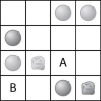Multiple Choice
After reading the paragraphs below, answer the questions that follow.
During a summer study abroad program, you travelled to Austria to study genetics at the University of Vienna. While you were there, a momentous discovery was made: some of Gregor Mendel's original lab books and notes were found to be buried outside of the abbey where he lived. It just so happened that the professor you were working with obtained copies of these notes and enlisted your help to decipher them.
You hired a translator to translate Mendel's notes from Czech to English, and using your knowledge of modern genetics (which Mendel did not have!) you were able to construct a partial Punnett square (shown below) . Because the notebook was damaged from being buried for so long, this is the only information that you have regarding a cross that Mendel must have performed. Your professor has tasked you with figuring out more about this experiment.

-In pea plants, round peas are dominant (R) and shriveled peas are recessive (r) , and yellow peas (shown as light gray in Punnett square) are dominant (Y) and green peas (dark gray) are recessive (y) . Using this information and the partial Punnett square above, what is the phenotypic ratio of the offspring pea plants in this Punnett square?
A) 12:1:1:4
B) 9:3:3:1
C) 3:3:1:1
D) 1:1:1:1
Correct Answer:

Verified
Correct Answer:
Verified
Q5: Which of the following statements regarding sickle-cell
Q7: Research since Mendel's time has established that
Q9: Sex-linked conditions are more common in men
Q19: Which of the following statements regarding prenatal
Q24: The mechanism that "breaks" the linkage between
Q35: Cats normally have a total of 18
Q44: Any gene located on a sex chromosome<br>A)
Q55: The chromosome theory of inheritance states that<br>A)
Q63: The alleles of a gene are found
Q65: What is meant by the statement that